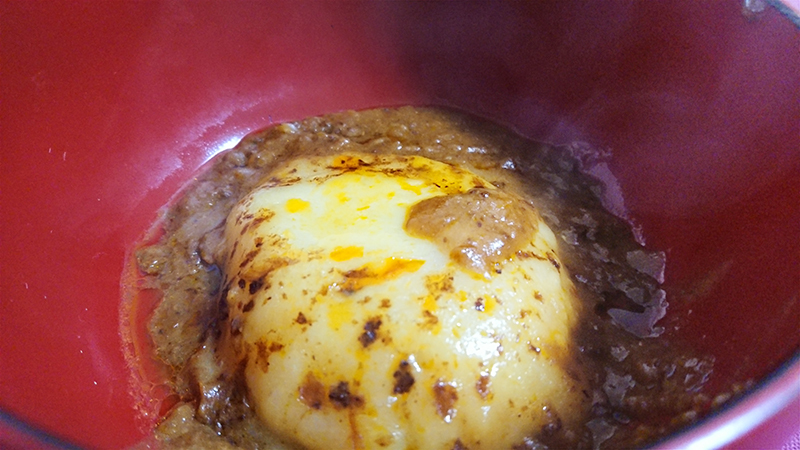A little while back, the "Wow, That Exists! Awards 2017" were announced. As the president of Yon-nana Club mentioned at the awards ceremony, what makes this prize unique is that the winning products are, at least currently, not yet famous nationwide. Regional newspapers hunt down "hidden gems that haven't made the news yet" to compete, so even the Grand Prix winner gives you that "Huh! That exists...?" feeling.
This year, the winner of that prestigious crown was "Bistro Sanmarche (Ehime)'s 'Kine-tsuki Mochi Curry'." Have you heard of it? No need to worry about that (laughs).

The retort pouch contains mochi made from locally grown rice and curry, so you just heat it up in hot water. No need to cook rice; you get a delicious meal in one dish. When we interviewed the judges, they highlighted two major evaluation points. One was "a novel combination that feels like it should exist but didn't." The other was "excellent flavor." It seems the victory was secured by perfectly capturing both the element of surprise and a sense of satisfaction.
By the way, Dentsu Inc. has a training method called "reverse-engineering." While typically you develop specific strategies based on a concept, this method involves inferring (≈ reverse-engineering) the underlying concept from an excellent specific strategy. Repeating this practice helps you train to capture intangible value in words.
For example, what happens if we reverse-engineer this "Pounded Mochi Curry"? Perhaps its concept could be described as "ready-to-eat meals with rice included." This certainly highlights one aspect of its appeal. But is it truly a novel angle worthy of a major award? Take supermarket shelves, for instance. They're lined with products sharing the same "ready-to-eat rice with curry" perspective—like microwaveable curry rice or mapo tofu bowls. Even calling it "locally sourced retort pouch" doesn't change that. These terms simply fail to express the unique ingenuity behind this product.

I bought this "Pounded Mochi Curry" myself. The liquid curry clings to the mochi's "stickiness," creating a chewy, springy texture. It was enjoyable as a solid food with distinct mouthfeel. It has a distinctive flavor that makes Chef Okuda of Bistro Sanmarche's claim that it's "his personal favorite" understandable. So perhaps the concept is "a soup that lets you enjoy texture"? Framing it this way might reveal the novelty of the idea a bit more. If so, should the next developments be "Pounded Mochi Corn Potage" or "Pounded Mochi Hatcho Miso Soup"? Are there no other ingredients or cooking methods besides "mochi" that can add texture to soup? Etc.
There's no single correct answer to "reverse-engineering." What we're doing here is akin to an "intellectual game." It's training. At the same time, the skill of "reverse-engineering" is incredibly useful in real product development too. Because it allows you to uncover the essence of that "something about it is just great!" feeling right in front of you, and use it as a guide for your ideas.
This is purely my personal view, but in the world of "advertising awards," I often see this "backtracking." Applicants take a step back to calmly re-examine their own work (setting aside the thought process of "how the concept led to the specific execution" from the production phase) and attempt to verbalize the "novelty" present through "backtracking." The judges do the same. What's usually required of them is to discover "new" guidelines through judging that will serve as references for the next generation. So, when the submitted materials lack sufficient explanation and fail to fully convey their appeal, judges themselves sometimes perform this "backtracking" to verbalize the value. You could call it "retroactive justification," but it's only through this process that they can move beyond a vague "This is kinda good!" to clearly discuss "What exactly is new here?"
Even when I asked the judges of the "This Exists!" Grand Prize what they found novel about the "Pounded Rice Cake Curry," I couldn't quite get a clear answer. To be honest, I still can't quite put its appeal into words myself. So, everyone, why not try it once and take on the challenge of reverse-engineering it?
Oh yes. My book, "How to Create Concepts: Dentsu Inc.'s Approach to Thinking That Also Helps with Product Development," has finally, after a year and a half, reached its second reprint (meaning the third printing). I'm delighted that the number of readers is steadily increasing, even if it's little by little, and I'd like to take this opportunity to express my heartfelt gratitude.

It also covers "reverse lookup."
Please, help yourself!









